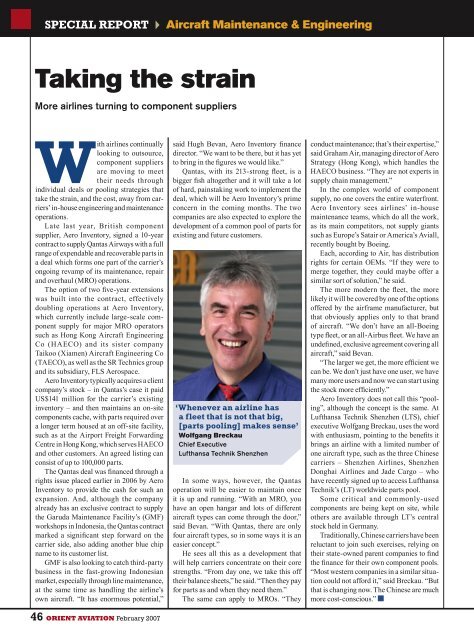Japan Airlines - Orient Aviation
Japan Airlines - Orient Aviation
Japan Airlines - Orient Aviation
- No tags were found...
You also want an ePaper? Increase the reach of your titles
YUMPU automatically turns print PDFs into web optimized ePapers that Google loves.
SPECIAL REPORTAircraft Maintenance & EngineeringTaking the strainMore airlines turning to component suppliersWith airlines continuallylooking to outsource,component suppliersare moving to meettheir needs throughindividual deals or pooling strategies thattake the strain, and the cost, away from carriers’in-house engineering and maintenanceoperations.Late last year, British componentsupplier, Aero Inventory, signed a 10-yearcontract to supply Qantas Airways with a fullrange of expendable and recoverable parts ina deal which forms one part of the carrier’songoing revamp of its maintenance, repairand overhaul (MRO) operations.The option of two five-year extensionswas built into the contract, effectivelydoubling operations at Aero Inventory,which currently include large-scale componentsupply for major MRO operatorssuch as Hong Kong Aircraft EngineeringCo (HAECO) and its sister companyTaikoo (Xiamen) Aircraft Engineering Co(TAECO), as well as the SR Technics groupand its subsidiary, FLS Aerospace.Aero Inventory typically acquires a clientcompany’s stock – in Qantas’s case it paidUS$141 million for the carrier’s existinginventory – and then maintains an on-sitecomponents cache, with parts required overa longer term housed at an off-site facility,such as at the Airport Freight ForwardingCentre in Hong Kong, which serves HAECOand other customers. An agreed listing canconsist of up to 100,000 parts.The Qantas deal was financed through arights issue placed earlier in 2006 by AeroInventory to provide the cash for such anexpansion. And, although the companyalready has an exclusive contract to supplythe Garuda Maintenance Facility’s (GMF)workshops in Indonesia, the Qantas contractmarked a significant step forward on thecarrier side, also adding another blue chipname to its customer list.GMF is also looking to catch third-partybusiness in the fast-growing Indonesianmarket, especially through line maintenance,at the same time as handling the airline’sown aircraft. “It has enormous potential,”said Hugh Bevan, Aero Inventory financedirector. “We want to be there, but it has yetto bring in the figures we would like.”Qantas, with its 213-strong fleet, is abigger fish altogether and it will take a lotof hard, painstaking work to implement thedeal, which will be Aero Inventory’s primeconcern in the coming months. The twocompanies are also expected to explore thedevelopment of a common pool of parts forexisting and future customers.‘Whenever an airline hasa fleet that is not that big,[parts pooling] makes sense’Wolfgang BreckauChief ExecutiveLufthansa Technik ShenzhenIn some ways, however, the Qantasoperation will be easier to maintain onceit is up and running. “With an MRO, youhave an open hangar and lots of differentaircraft types can come through the door,”said Bevan. “With Qantas, there are onlyfour aircraft types, so in some ways it is aneasier concept.”He sees all this as a development thatwill help carriers concentrate on their corestrengths. “From day one, we take this offtheir balance sheets,” he said. “Then they payfor parts as and when they need them.”The same can apply to MROs. “Theyconduct maintenance; that’s their expertise,”said Graham Air, managing director of AeroStrategy (Hong Kong), which handles theHAECO business. “They are not experts insupply chain management.”In the complex world of componentsupply, no one covers the entire waterfront.Aero Inventory sees airlines’ in-housemaintenance teams, which do all the work,as its main competitors, not supply giantssuch as Europe’s Satair or America’s Aviall,recently bought by Boeing.Each, according to Air, has distributionrights for certain OEMs. “If they were tomerge together, they could maybe offer asimilar sort of solution,” he said.The more modern the fleet, the morelikely it will be covered by one of the optionsoffered by the airframe manufacturer, butthat obviously applies only to that brandof aircraft. “We don’t have an all-Boeingtype fleet, or an all-Airbus fleet. We have anundefined, exclusive agreement covering allaircraft,” said Bevan.“The larger we get, the more efficient wecan be. We don’t just have one user, we havemany more users and now we can start usingthe stock more efficiently.”Aero Inventory does not call this “pooling”,although the concept is the same. AtLufthansa Technik Shenzhen (LTS), chiefexecutive Wolfgang Breckau, uses the wordwith enthusiasm, pointing to the benefits itbrings an airline with a limited number ofone aircraft type, such as the three Chinesecarriers – Shenzhen <strong>Airlines</strong>, ShenzhenDonghai <strong>Airlines</strong> and Jade Cargo – whohave recently signed up to access LufthansaTechnik’s (LT) worldwide parts pool.Some critical and commonly-usedcomponents are being kept on site, whileothers are available through LT’s centralstock held in Germany.Traditionally, Chinese carriers have beenreluctant to join such exercises, relying ontheir state-owned parent companies to findthe finance for their own component pools.“Most western companies in a similar situationcould not afford it,” said Breckau. “Butthat is changing now. The Chinese are muchmore cost-conscious.”46 ORIENT AVIATION February 2007








![OAMag-V7N4-Cover [Converted] - Orient Aviation](https://img.yumpu.com/48598575/1/190x255/oamag-v7n4-cover-converted-orient-aviation.jpg?quality=85)







